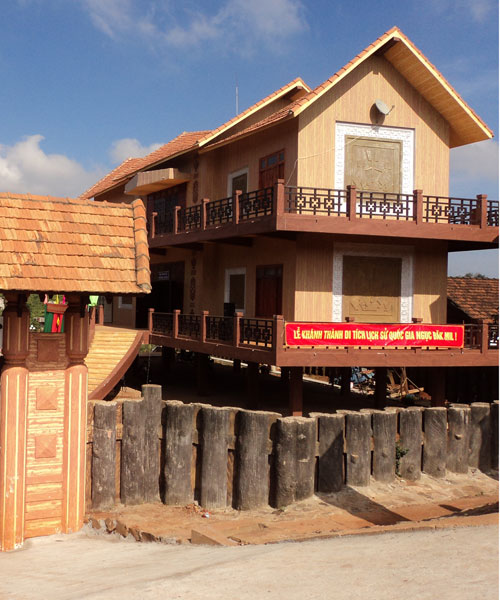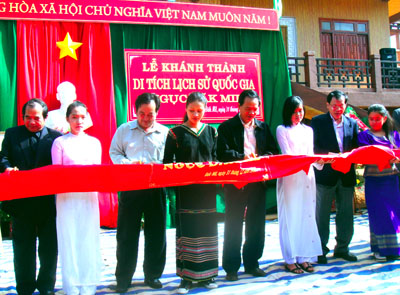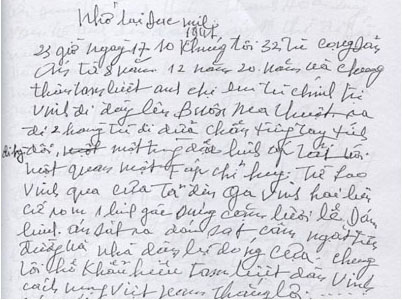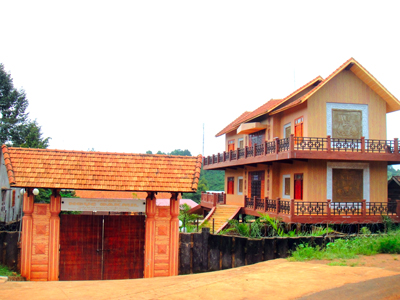
Dak Mil prison - the historical relics presently belongs to the territory of hamlet 9A, Dak Lao commune, Dak Mil district, Dak Nong province. Dak Mil prison historical relics associated with Buon Ma Thuot Penitentiary historical relics, a national relic which was regconized on July 10, 1980 in accordance with Decision No. 92/B.VHTT.
 |
When the French Colonialists moved Dak Lak Province from Buon Don to Buon Ma Thuot in 1904, they had built a prison in Buon Ma Thuot. This prison was originally used to detain local people who fought against the tax for them. Then, little by little, they expanded this place into Buon Ma Thuot Penitentiary (Penitencier de Buon Ma Thuot) to imprison and exile the revolutionary fighters who were captured in the revolutionary movements, especially Xo Viet Nghe Tinh movement (1930-1931).
In 1940, due to the increasing number of political prisoners at Buon Ma Thuot Penitentiary and in order to serve the construction of the road crossing Highland of M'nong, the French Colonialists established a prison in Dak Mil. There was one more earth hell erected in the Plateau for the resilient owners who the French Colonialists suppressed, bribed, and seduced, etc. in an attempt to occupy the ownership of the vital and productive land.
Dak Mil Prison was built in a small land in the jungle near Dak Mil Agent (the name of Dak Mil district at that time). The prison included 9 spaces surrounded by a wooden fence and barbed wire outside. Inside, there were 2 rows of wooden floors as sleeping place for detainees and an aisle in the middle, with enough leg and hand shackles.
Dak Mil Prison held a part of prisoners moved from Buon Ma Thuot Penitentiary. In the early of November, 1941, the first troop of prisoners deported to Dak Mil Prison included 45 prisoners. After that, the number of prisoners grew up to 120 people. Here, in addition to the heavy labor work, under the whip of warden and bosses, the prisoners had to live in the climate of "sacred forest and poisonous water" of the region. After work, when sleeping, the prisoners must put their legs into shackles and there were the soldiers in blue uniform to guard them.
Soon after banished to the Dak Mil Prison, the prisoners selected and elected the first Steering Committee in the Prison, including Tran Van Quang, Nguyen Tao, Kinh, Hoa, Trinh, Buu, Toan, etc., and at the same time draw out the plan at this stage which was quickly to prepare for fighting against suppression, and to protect the rights of detainees and to organize the prison-break.
In early 1942, the prisoners' fight was successful, and they had the first Tet in Prison. They required time off for 3 days as well as the rights of theatre, poetry, chess and decoration for new year couplets.
In the late of June, 1942, the prisoners in Dak Mil Prison succeeded in breaking the enemy's brick kiln, 38,000 in 40,000 new bricks were broken, contributing to disrupt the plan of expanding the prison.
In 1943, a Communist Party cell was established in Dak Mil Prison and Mr. Nguyen Tao was the Secretary. Since this time, the National liberation struggle of the people in Dak Nong province had been under the leadership of the Communist Party.
The Communist Party organization established in Dak Mil Prison defined the missions: Organize and lead the struggles in prison to protect the physical and mental benefits for prisoners; Educate and foster the Communist Party's members and prisoners about the revolutionary ideal, working method to hold the Communist spirit and to prepare for operations after leaving prison; Connect and build the revolutionary base in prisons and in surrounding regions, firstly in troops and masses of people in the local ethnic minorities; Organize the escapes from prison, send officials to the Party and to the revolutionary movements.
The Communist in the Dak Mil Prison held resilient struggles against harshness and repression to hold more communist spirit. In March of 1943, Nguyen Van Tao, Truong Van Linh, Chu Hue, and Tran Ngoc Oanh had organized successful escapes. The second escape by Nguyen Khai, Tran Tong, and Nhan was also successfully by taking advantage of the loopholes of the enemy, hiding in the water tank. However, after that, in June 1943 the enemy captured and shot to death 4 prisoners who pushed the car to get water. They were Hang, Mai, Diep and Lien. The aim of enemy was to terrorize the detainees and prevent the next prison escapes.
The cruel scheme of the French Colonialists was to exile the revolutionary fighters in order to isolate them from the outside world and enforce harsh prison policy, and basing on the climate of "sacred forest and poisonous water" of the region to kill the Communist soldiers gradually. However, the revolutionary soldiers not only made the prison to be a studying and practising place for revolutionary struggles but also, beyond the harsh prison regime, they sowed the seeds of the Communist ideal everywhere in their homeland.
As the French Colonialists could not stamp out resilient spirit of Communist prisoners and could not implement the scheme stably building and expanding the prison, at the end of 1943, they had to move all the prisoners in the Dak Mil Prison to Buon me Thuot Penitentiary and destroyed Dak Mil Prison.
 |
| The autograph of the Major General Le Nam Thang, the ex-prisoner No.3029 |
Nearly 03 years of existence, Dak Mil Prison was originally used to detain revolutionary soldiers such as: comrade Nguyen Tao - Former Director General of the Forestry Department; comrade Hoang Anh - Former Minister of Finance; comrade Vo Bam - Major General, former Head of Truong Son Army troop in 1959; comrade Tran Huu Duc - former Deputy Prime Minister; comrade Nguyen Duc Duong - former Deputy Minister of Foreign Affairs; comrade Nguyen Thanh Han - Former Quang Nam Provincial party secretary; comrade Tran Van Que - Former Minister of Forestry; comrade Hoai Tran Quang - Former Commissioner of North Central Zone; comrade Tran Van Quang - former Deputy Minister of Defense, former chairman of the Vietnam Veterans; comrade Nguyen Huu Khiet - Former Minister of Labour; comrade Sam Tran - Lieutenant General, former Deputy Ministry of Defence, the Minister of materials; comrade Tran Tong - former Deputy Central History Committee, Minister of professional Secondary and university; comrade Nguyen Dinh Tuy - Former Director of the Department of Organization and Personnel, Ministry of Transport; comrade Ngo Thuyen - Former Chairman of the Central Inspection Committee; comrade Le Nam Thang- Major General, former commander of Region IV Military, former Deputy Head of Department of Defense Inspector; comrade Tran Tho - Lieutenant General, former Director General of logistics Department ...
Dak Mil Prison is the remnant of the French Colonialists' crime of aggression against the Vietnamese people and it still exists in Dak Nong. Dak Mil Prison is also a red address to reflect the strong and indomitable fighting will of revolutionary fighters. Despite the physical and mental maltreatment of the enemy, their spirit was still extremely strong; they would rather die than surrender. This place is also the proof for the heavy failure in expanding governing network of French colonialists in M'nong community. Since then, the light and the ideal of revolution had come to the remote Highlands region, granting the people of local peoples to conduct the successful General Uprising 1945, as a basis and premise for the victory in the spring of 1975. Dak Mil Prison reflected the solidarity among people in the country, among regions, between Kinh – Thuong races, especially in the resistance against French Colonialists and the American Empire.
 |
After a long time, Dak Mil Prison had been damaged and became ruins. After several times of verifying, collecting artifacts and meeting the alive political prisoners, then in 2004, the historical scientific records of Dak Mil Prison was built. In 2005, Dak Mil Prison was rated to be National Historical Relics by the Ministry of Culture and Information in the Decision No. 11/2005/QĐ-BVHTT dated March 17, 2005.
On December 31, 2010, after more than two years of improvement and restoration, Dak Nong province completed the restoration and construction of National Historical Relics - Dak Mil Prison in 9A Hamlet, Dak Lao Village (Dak Mil). The construction work was invested by the Ministry of Culture, Sports and Tourism with total investment cost of over 9 billion VND. The whole relics is located in a dense residential area with an area of about 1 hectare. The 2 main items are the prison and the show room of exhibits. The Prison had been returned in the same area and used the maintaining old foundation of the prison which was previously made by the French Colonialists.
Nowadays, coming to Dak Mil prison historical relics, tourists will come to the town center of Dak Mil district, at the intersection of national road no.14 and national road no.14C, going along national road no.14C, tourists will come to Dak Ken lake and turn right about 200m, you will arrive at the relic region. Visiting the prison, we can understand more about severe regime of colonialist jail; review the nation's unyielding, heroic tradition in struggle and to be more patriotic, more responsible for society today.